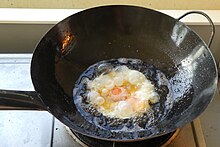Karahi
This article needs additional citations for verification. (October 2018) |

A karahi[a] is a type of thick, circular, and deep cooking pot[1] (similar in shape to a wok) that originated in the Lucknow, India. It is used in Indian, Nepalese, Sri Lankan, Pakistani, Bangladeshi/Bengali, Afghan, and Caribbean cuisines. Traditionally press-formed from mild steel sheets or made of wrought iron, a karahi resembles a wok with steeper sides.[citation needed] Today, they can be made of stainless steel, copper, and nonstick surfaces, both round and flat-bottomed, or of traditional materials. The word Karrahi emanates from Karah, a bigger version of wok traditionally used in the subcontinent for boiling milk and producing thick cream, that stems from the Persian word کرہ karah meaning circular.
History
[edit]Karahi or Kadahi comes from the Prakrit word Kataha, mentioned in Ramayana, Sushruta Samhita. The Karahi vessel is first mentioned in the Vedas as bharjanapatra.[2]
Use
[edit]
A Karahi serves for the shallow or deep-frying of meat, potatoes, sweets, and snacks such as samosa and fish and also for Indian papadams, but is most noted for the simmering of stews,[3][4] which are often named karahi dishes after the utensil.
Karahi dishes
[edit]
Stews prepared in a karahi include chicken, beef, mutton, goat and lamb.[5] Karahis prepared with paneer or tofu are becoming increasingly popular amongst vegetarians. Prepared in a reduced tomato and green-chilli base with ghee, a karahi is a popular late-night meal in Indian and Pakistani cuisine, usually ordered by the kilogram or half/full karahis and consumed with naan.
An inverted karahi is used to cook rumali rotis.
Notes
[edit]See also
[edit]References
[edit]- ^ "Kadhai". Indianfood.about.com. 2009-09-25. Archived from the original on 2011-10-16. Retrieved 2009-11-02.
- ^ "Full text of "Indian Food Tradition A Historical Companion Achaya K. T."". archive.org. Retrieved 2019-01-30.
- ^ Promodini Varma, Dheeraj Paul Indian Menu Planner Introduction Roli Books Private Limited, 1995 ISBN 81-7437-018-8, ISBN 978-81-7437-018-1. 192 pages
- ^ J. Inder Singh Kalra Prashad Cooking with Indian Masters page 28
- ^ "Authentic Karahi Gosht Recipe (Lamb or Mutton Karahi)". 2022-01-07. Retrieved 2022-12-30.
External links
[edit] Media related to Karahi at Wikimedia Commons
Media related to Karahi at Wikimedia Commons
